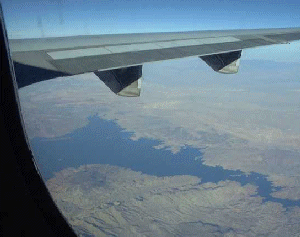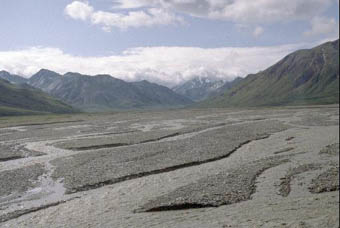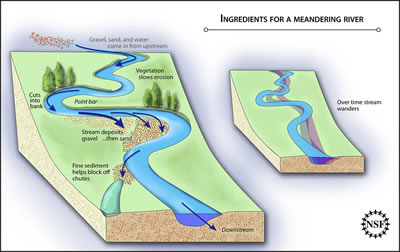This stream carries sediment that has weathered from mountains in Alaska.
Click on image for full size
Courtesy of Bruce Molnia, Terra Photographics
Step 2: Sediments on the Move!
If you sneeze into a pile of dust the little particles fly everywhere, but if you sneeze into a pile of rocks, they will stay put. It takes more force than a sneeze to move those rocks. Winds and water can have enough force to move rocks.
Very small pieces of sediment like mud and clay are picked up very easily by moving wind and water. But they can settle to the bottom of calm lakes or to the ground when the air or water stops moving.
Larger pieces of sediment can be carried in a stronger current, like fast moving water. Sediment that can sink to the bottom in a fast moving river must be very large and heavy.
Last modified August 25, 2003 by Lisa Gardiner.
You might also be interested in:

Wind is moving air. Warm air rises, and cool air comes in to take its place. This movement creates the winds around the globe. Winds move at different speeds and have different names based on their speed.
...more
Rivers are very important to Earth because they are major forces that shape the landscape. Also, they provide transportation and water for drinking, washing and farming. Rivers can flow on land or underground
...more
If you sneeze into a pile of dust the little particles fly everywhere, but if you sneeze into a pile of rocks, they will stay put. It takes more force than a sneeze to move those rocks. Winds and water
...more
When water or wind slows down, sediment can no longer be carried in it. The particles of sediment fall through the water or air and form a blanket of sediment on the bottom of a river, a lake, ocean,
...more
Scientists have used a model of a river to learn more about how healthy rivers are formed. Healthy rivers have sections that are shallow, and other sections that are deep. These different types of water
...more
An aquifer is the name for a layer of rock which is capable of holding a large amount of water. Some layers are better at holding water than others, for example a layer of sandstone can hold a good deal
...more
When waves get to the beach at an angle, water moves along the coast in a longshore current. Longshore currents grow stronger when the waves come towards the beach at a large angle, if the waves are large,
...more














